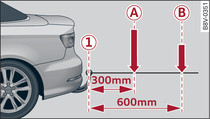|

- Fig. 1 Load distribution of equipment and accessories (illustration shows an example vehicle)
Applies to vehicles: with steel towing bracket
Before mounting equipment and accessories (e.g. bicycle rack) please observe the following notes.
The following description does not apply to towing brackets made of aluminium.
The equipment/accessories mounted must not protrude more than 700 mm from the ball joint -1-.
The total weight (mounted equipment plus the load) must not exceed 75 kg.
The maximum load depends on where the centre of gravity lies.
The maximum weight decreases as the distance between the centre of gravity and the ball joint -1- increases.
The following limits apply:
If the distance is 300 mm, the total weight (incl. the equipment mounted) -A- must not exceed 75 kg.
If the distance is 600 mm, the total weight (incl. the equipment mounted) -B- must not exceed 35 kg.
Only bicycle racks for a maximum of three bicycles may be used.
Equipment mounted on the towing bracket
Please make sure that the equipment mounted has been approved by the manufacturer for use on the ball joint. If you mount unsuitable equipment, this can cause damage to the towing bracket. In an extreme case, damage to the towing bracket could cause it to break WARNING!.
- Make sure that the equipment and accessories have been approved for use on Audi vehicles.
- Use of unsuitable equipment can result in severe damage to the towing bracket. The towing bracket could then break while using the equipment or while pulling a trailer (accident risk).
- Never use tools of any kind when fitting and removing the ball joint. This could damage the mechanism which locks the ball joint in place and impair its safety (accident risk).
- When using equipment mounted to an aluminium towing bracket rather a steel bracket, the load carried must be reduced (e.g. two bicycles instead of three). If loads are too heavy this can lead to damage and, in extreme cases, cause the towing bracket to break.
